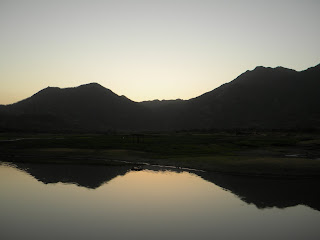If you are puzzled to find out best suitable place to hang out for two days near by Ahmedabad, then what can be the best other then Jessore Sloth Bear Sanctuary. No need to go far away – out of
I have heard many a times from my colleagues that “Oh Yaar!! We are so bored, we don’t have single natural place to hang out in weekend near Ahmedabad. Fortunately as a natural lover, I searched out the place and been there for two days one night two times. First I visited it in monsoon and secondly I visited it in this summer – month of April. Natural beauty is stunning in both seasons.
Let me first brief you about the Sanctuary and its history. Jessore Sloth Bear Sanctuary is situated in the Banaskantha district, 25 kms. from Palanpur. It was declared as Wildlife Sanctuary in May 1978. This 180.66 sq.km. forest tract of Jessore hill and adjoining area is endowed with several rare and endangered species of flora and fauna. The forests of the sanctuary play an important role in conservation of diminishing Aravali ecosystem. This area acts as a buffer and separates the desert ecosystem from the dry deciduous type of ecosystem. The tree clad terrain helps in arresting the process of desertification and advancement of
When I went in monsoon, nature was best in its beauty. A green carpet was put on by earth, and sweet voice of different birds can be heard thought the day. The lake in front of the tents and cottages was full of water. One can walk around the lake in the pleasant breeze. This is the best season to visit the sanctuary.
Places To see within sanctuary:
Apart from its natural beauty sprinkled every where, from the lake point, one can go to Kedarnath temple. This temple is of lord Shiva and situated above 200 meters in the mountain. There are row stairs to reach there passing through jungle. It is very enjoyable path way. You will find many water streams in between. Also be able to see some blue bulls, and different types of birds. You may not encounter with Sloth Bear as they stay away from this path and their caves and inhabitant is in deep forest. But be watchful, you will find lot many different kinds of species around. Also along the walk, some points have been constructed by forest department to take rest near by water streams. One can drink water of these streams as they are pure and natural. You may find local public going to Kedarnath as pilgrimage. People living parts of
After reaching
Please note that you should not take any loading baggage with you. If you want a stick will be sufficient and advisable as well. You should not take or through garbage or plastic bags in the jungle.
Where to stay:
There are different charges for cottages depending on number of people. Minimum is 250 per day for a couple with facilities mentioned above excluding food. There are dormitories for maximum 50 persons as well.
Staying at cottages is safe. One should stay here to see the sparkling stars in night without light pollution.
To reserve cottage, contact RFO (Range Forest Officer) or Dy. CFO of Banaskantha district.
Other near by places to visit are Ambaji (around 50 KMs), and Balaram (15 KMs). Balaram has heritage hotel which was erstwhile palace turned into hotel now. It is run and managed by the famous Gopi Group. Parts of many films and TV programs are being shoot at this palace. The first film shoot here was Suryavansham. When I visited the palace hotel recently, shooting of Kathputli serial was going on. This is also a good place to stay in weekends. It is on the bank of river and surrounded by jungle like environment.
Post-monsoon to winter is the best time to visit the Sanctuary. The nearest railway stations are Palanpur; 25 kms. and Iqbalgadh; 8 kms. The Nearest airport is Ahmedabad (178 kms).
By air: Nearest airport is Ahmedabad
Location: Banaskantha District – 25 km. from Palanpur.
Area: Approx. 180 sq.km.
Wildlife: Sloth bear, leopard, sambar, blue bull, wild boar, porcupine and variety of birds.
Nearest Airport: Ahmedabad – 190 km.
Railway Station: Palanpur – 25 km. and Iqbalgadh – 8 km.
Contact: Dy. Conservator of Forests, Banaskantha Division, Palanpur. Phone: 02742-57084
For more photos please visit to my web album @ http://picasaweb.google.com/hariax/JessoreSlothBearSanctuary#




